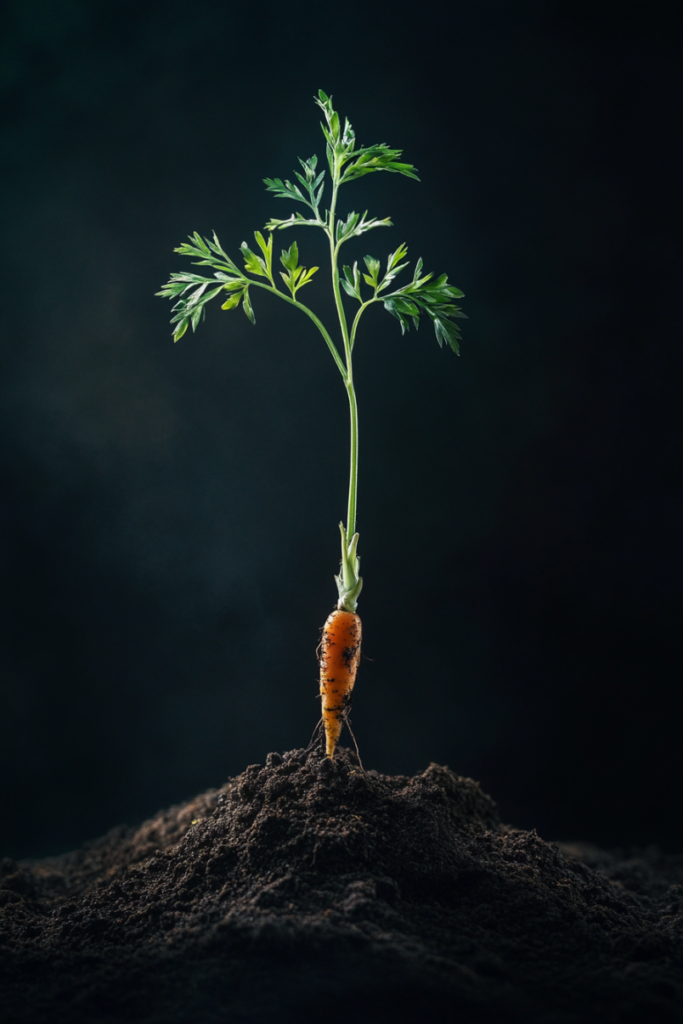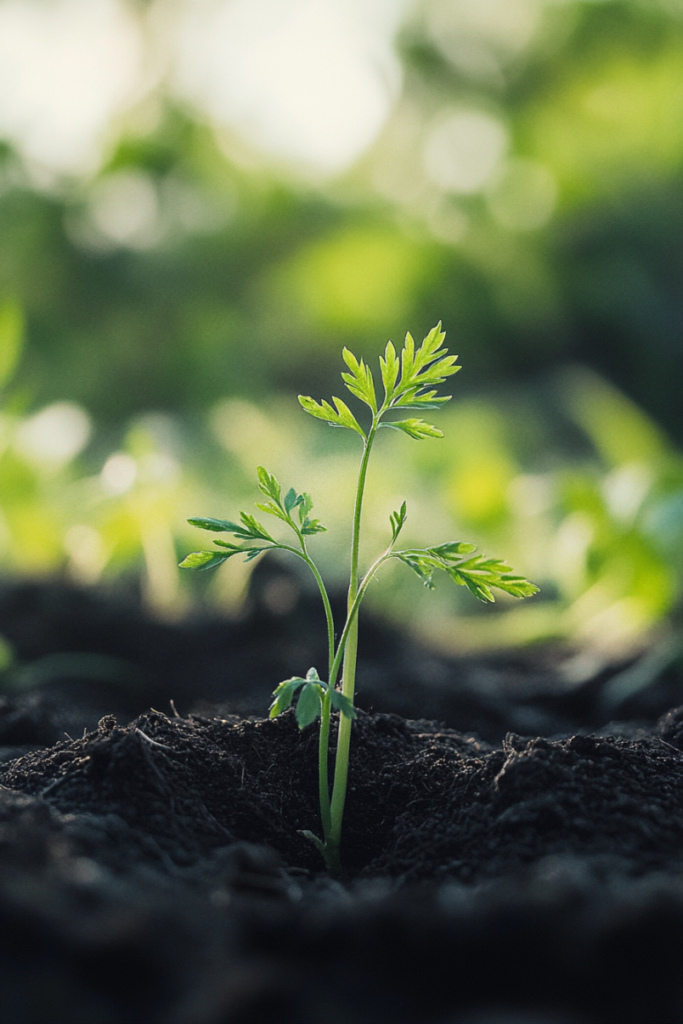
Carrots are a beloved root vegetable, appreciated for their crunchy texture and sweet taste.
They’re a common sight in gardens and kitchens around the globe.
However, growing healthy and vibrant carrots goes beyond simply planting seeds and watering them.
Proper fertilization is essential to provide the nutrients your carrots need to grow strong roots and yield a plentiful harvest.
Understanding Carrot Nutrition Needs
Carrots, like all plants, need a balanced mix of nutrients to thrive.
The three main macronutrients essential for carrot growth are nitrogen (N), phosphorus (P), and potassium (K).
However, each nutrient plays a specific role in the development of carrots:
- Nitrogen (N): Promotes leafy green growth. While important, too much nitrogen can cause excessive leaf growth at the expense of root development.
- Phosphorus (P): Supports root development, making it crucial for carrots since they are root vegetables. Phosphorus also aids in the transfer of energy within the plant.
- Potassium (K): Enhances overall plant health, improves drought tolerance, and supports the development of strong, well-formed carrot roots.
Carrots also require secondary nutrients like calcium, magnesium, and sulfur, as well as trace elements like zinc and boron.
A deficiency in any of these nutrients can lead to poor growth and misshapen roots.
Stat: According to a study published in the Journal of Plant Nutrition (2020), carrots with balanced fertilization showed a 25-30% increase in yield compared to unfertilized crops.

Fertilization Methods for Carrots
When it comes to fertilizing carrots, you have two main options: organic and inorganic methods.
Both approaches have their pros and cons, and the best method often depends on your gardening preferences and soil condition.
Organic Fertilization
Organic fertilization is an eco-friendly approach that enriches the soil with natural nutrients.
Here are some organic options for fertilizing carrots:
Compost
Compost is a rich source of nutrients, especially phosphorus and potassium, which are essential for root development.
Adding compost to your carrot bed improves soil structure and provides slow-release nutrients.
Tip: Mix 2-3 inches of compost into the top 6-8 inches of soil before planting your carrot seeds.
Avoid using compost with a high nitrogen content, as this can encourage excessive leaf growth.
Manure
Aged manure is another excellent source of organic matter and nutrients.
However, fresh manure should be avoided, as it can burn young plants and lead to nutrient imbalances.
Fact: Research from the Journal of Organic Agriculture (2021) found that using aged manure improved carrot yield by 15%, compared to unfertilized plots.
Green manure
Green manure involves planting cover crops, such as clover or legumes, that are then tilled into the soil.
These plants help fix nitrogen in the soil and improve its structure, making it a good option for boosting fertility before planting carrots.
Inorganic Fertilization
Inorganic fertilizers are commercially produced products that deliver precise amounts of nutrients to your carrots.
These fertilizers are often used when specific nutrient deficiencies are detected through soil testing.
Commercial fertilizers
Commercial fertilizers come in granular or liquid form and typically feature N-P-K ratios that indicate the proportion of nitrogen, phosphorus, and potassium.
For carrots, a fertilizer with a balanced or lower nitrogen ratio is recommended, such as a 5-10-10 or 3-6-6 formulation.
Tip: A common recommendation is to apply about 1.5-2 pounds of fertilizer per 100 square feet of carrot bed before planting.
This can vary depending on soil test results.
Fertilizer ratios for carrots
When choosing a fertilizer for carrots, look for one with a higher phosphorus content to support strong root growth.
Ratios like 2-3-2 or 3-4-3 are often ideal for root vegetables.
Side dressing vs. broadcast fertilization
Side dressing involves applying fertilizer in narrow bands beside the carrot rows, which allows the nutrients to be absorbed directly by the roots.
Broadcast fertilization means spreading the fertilizer evenly across the entire planting bed.
This method is more common when applying organic fertilizers like compost or manure.

Fertilization Timing and Application
When and how you fertilize your carrots plays a crucial role in their development.
Proper timing ensures that nutrients are available when the plants need them most.
Fertilization during the planting stage
Before planting, work organic matter such as compost or manure into the soil.
You can also apply an inorganic fertilizer at this stage to ensure the soil is rich in phosphorus and potassium.
Carrots benefit from having a nutrient-rich environment as they begin to grow.
Tip: Carrot seeds are tiny and should be sown shallowly.
Applying fertilizer directly to the planting trench can harm seedlings, so it’s best to fertilize the soil before planting.
Fertilization during the growing season
Once your carrots start growing, you can apply a side dressing of fertilizer to support their ongoing nutrient needs.
Generally, applying fertilizer 3-4 weeks after planting is a good time to boost growth.
Focus on low-nitrogen fertilizers that will promote root development rather than excessive leaf growth.
Fact: According to the Agronomy Journal (2020), side dressing carrots with a balanced fertilizer during the early growth stage increased root size by 20-25%.
Factors affecting fertilization timing
Several factors can influence the best timing for fertilizing carrots, including:
- Soil type: Sandy soils tend to drain nutrients quickly, requiring more frequent fertilization, while clay soils hold onto nutrients longer.
- Climate: In hot, dry climates, nutrients may leach out of the soil more quickly, meaning you’ll need to fertilize more often.
- Rainfall: Heavy rains can wash away nutrients, especially in sandy soils, so be prepared to reapply fertilizer after significant downpours.
Application techniques
There are a few different ways to apply fertilizer, depending on your method and materials:
- Spreading (broadcasting): This is common with organic fertilizers like compost. Simply spread the material evenly over the soil.
- Banding: For inorganic fertilizers, banding involves placing the fertilizer in rows near the plants, ensuring that nutrients reach the roots directly.
- Liquid fertilizers: These can be applied with watering, offering a quick boost of nutrients.

Tips for Effective Carrot Fertilization
Soil testing to determine nutrient needs
Before applying any fertilizer, it’s a good idea to test your soil.
A soil test will reveal what nutrients are already present and whether you need to add any specific ones.
Fact: The University of California Agriculture & Natural Resources recommends testing soil every 2-3 years for optimal results, especially before starting new garden projects.
Avoiding over-fertilization
While it might be tempting to apply more fertilizer in hopes of bigger carrots, too much of a good thing can lead to problems.
Over-fertilization, especially with nitrogen, can cause “forking” of carrot roots, making them less marketable and harder to harvest.
Considering environmental factors
Fertilizer can be affected by weather conditions.
Rain, wind, and extreme heat can all impact the effectiveness of your fertilization efforts.
For instance, windy conditions can blow away granular fertilizer before it has a chance to penetrate the soil.
Monitoring carrot growth and adjusting fertilization accordingly
Carrots are slow to grow, so it’s important to monitor their progress and adjust fertilization if you notice issues like yellowing leaves (a sign of nutrient deficiency) or poor root development.

Final Thoughts
Properly fertilizing your carrots is crucial for growing healthy and tasty roots.
By learning about your soil’s needs, selecting the right fertilizers, and timing your applications well, you can enhance both the quantity and quality of your carrot harvest.
Whether you choose organic or synthetic methods, using the tips in this guide will help you grow strong, vibrant carrots that you can enjoy.



